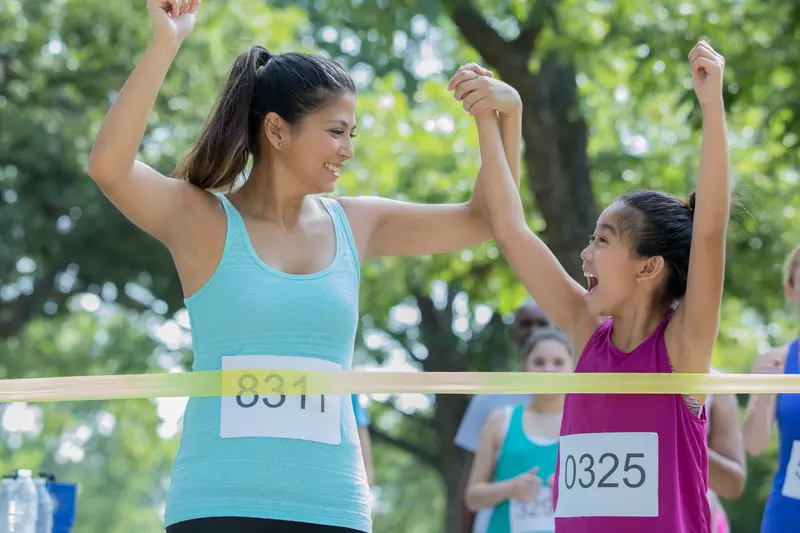- AdventHealth

As a parent who runs, you’re probably hoping your children will come to love running as much as you do. Your enthusiasm, hard work, and love for the sport sets an influential example for your kids and can help teach them lessons that extend to all areas of their lives.
While teenagers may start with a more intensive, organized approach to training, younger children should have one primary focus: fun!
Running for Young Children
Running should be a playful, low pressure outlet for kids. No matter how much you love to run, keep in mind that your kids may not feel the same way. But if you make running fun and lighthearted for children right from the start, they’re much more likely to have a positive experience that sets the foundation for the future, too.
Doug Allen, a physical therapist for AdventHealth, agrees. “Make running fun and less of a ‘workout.’ It should come naturally for a child to go run on their own and not be forced to run for fitness in order for them to stay with the sport for long term. Playing kickball in the neighborhood, playing tag with their friends, and participating in a hockey game in the street in front of the house all counts as running.”
Under the age of six, games like tag, racing to the mailbox, or running with a dog around the yard are perfect ways to get kids moving. Cheering for a parent or older sibling at a race can be an introduction to the fun and challenge of competition and provide another great option for staying involved.
Allen agrees, “Children can lose interest with running long distances. More importantly, you want to protect them from injury because long distance running can put too much force on their joints.”
Running for School-Aged Children
Between the ages of six and eight, kids will begin to build more endurance and can join you for longer runs on quiet neighborhood roads and trails. Just like any new runner, they should start on a route that’s short and flat with intervals of walking and running.
Kids tend to have one speed — full steam ahead! So it will take some practice to get them to slow down as they learn to run longer and farther. Start with outings just once or twice weekly and build time and distance very gradually if they enjoy it.
As your children get a little older (between the ages of eight and twelve), running and training can take on a more organized form. Local chapters of national organizations like Girls on the Run, or even informal neighborhood outings can provide group fun and camaraderie. As long as there is ample supervision, the more the merrier for most kids. This also allows for friendly support and healthy competition.
Allen agrees, noting “This age group is getting stronger. They can tolerate more impact over longer distances and can have a bigger cardiovascular base for longer distances.”
Always keep your training and racing goals separate from the activities you do with your kids. Pressuring kids into running can backfire, no matter how positive your intentions may be. You can always offer for kids to join you on part (or all) of a run, but allow them to be the ones to make the final decision about participation. And continue to offer even if they decline initially — you may get a “yes” when you least expect it.
Tips to Keep Running Playful
When you introduce children to running, keep it fun and varied as they explore their new activity. Variety in location, group size, distance and speed will help maintain their interest and allow them to explore different ways to enjoy running.
Here are some options to help running feel playful while also allowing kids to participate in the planning and decision-making process:
- Map out a local loop: Find a neighborhood loop where you can safely walk or run together with your children. Set goals such as completing the loop a certain number of times or running portions to give them a chance to push themselves in a more relaxed way.
- Let kids do the planning: Kids are more likely to enjoy a running-related outing if they are allowed to be a part of the planning process. Depending on their age, give them a chance to help choose a location, pace or distance.
- Try the track: While tracks can be monotonous for longer runs, their small size and controlled environment make them a place where family members can easily run together at a variety of paces. Take turns running faster and slower so you all have an opportunity to be together at different times.
- Fun fartleks: Fartlek means "speed play" in Swedish. It’s a type of running where you mix long and short runs. This approach can be ideal for giving kids an opportunity to run shorter, faster paces. Keep them unstructured and use landmarks to speed up and slow down, such as running faster between mailboxes or trees on a wooded path.
- Play on the trails: Flat, non-technical trails are more interesting than roads, and give kids an opportunity to interact with nature. Local nature trails and parks can help them experience the beauty of the outdoors while being active.
- Enjoy the scenery — and plan for stops and starts: When you run with kids, embrace the idea that you’ll be stopping and starting. Use this opportunity to explore the environment around you. Focus on the fun, not the competition.
- Run while they bike: Depending on your family’s fitness, taking turns biking and running can help everyone maintain a pace that is comfortable for the group, yet it allows everyone to stay together. Alternate who runs and bikes to give everyone a chance to improve their running fitness.
- Complete a fun run as a family: Many races - both large and small - offer fun runs to get kids involved in a positive, non-competitive environment. Depending on their age you can run with your kids or cheer them on from the sideline.
- Set goals to emphasize progress over winning: While competitive racing may be in their future, avoid any emphasis on “winning” at an early age. Goal setting for kids should allow them to feel positive and encouraged. Encourage them to compete against themselves rather than others, and help them learn techniques to run longer or faster more comfortably.
- Prepare for the weather: Check the weather before running out the door. If a rain shower is expected, bring some ponchos or consider a shorter run to make it home in time. Plan for hotter weather by bringing extra water and plan to run shorter distances in shadier spots. If a cold front is approaching, layer up to stay warm.
When you’re sharing the joy of running with your kids, keep the focus on them and their needs. Remember that this is an opportunity for time together rather than serious training. Begin with a fun, positive approach to running, and you may see a budding runner for a lifetime.
Learn more about how AdventHealth Sports Med and Rehab can help your whole family stay active, healthy and strong in body, mind and spirit.



